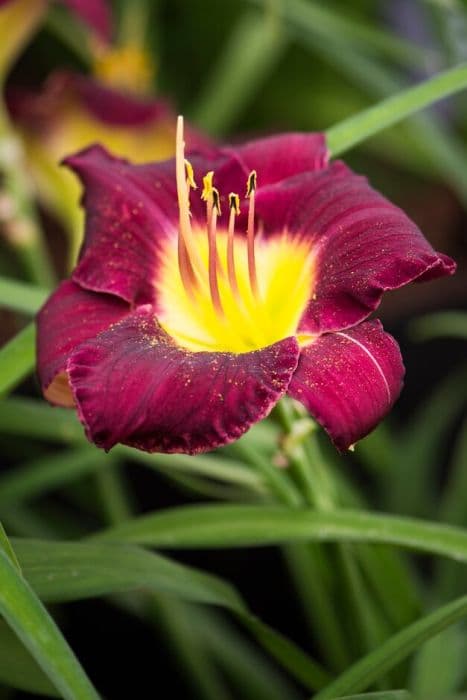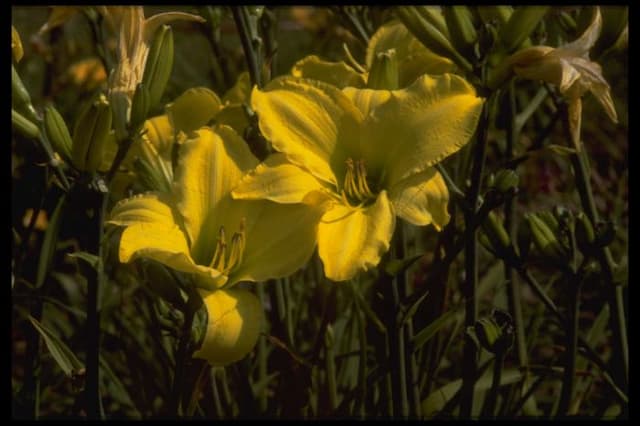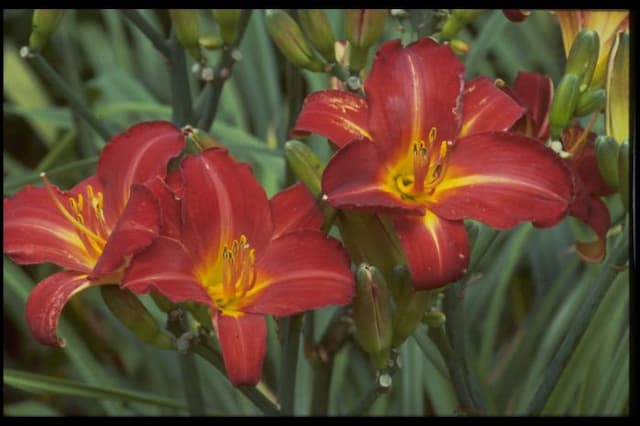Daylily Hemerocallis 'Luxury Lace'

ABOUT
The Hemerocallis 'Luxury Lace,' commonly known as the Daylily 'Luxury Lace,' is a perennial plant notable for its enchanting flowers. Its blossoms are a stunning visual delight with their rich, creamy color, which often draws comparisons to a pale yellow or soft ivory. Each petal is exquisitely edged with crimped, lacy fringes that enhance the flower's delicate beauty. The blooms open to reveal a striking throat, where the color deepens or contrasts to create an eye-catching effect. The flowers are borne atop sturdy, arching stems that gracefully emerge from a lush clump of foliage. The leaves of the daylily are long, slender, and green, forming a dense mound that provides a verdant backdrop for the floral display. The leaves may have a slightly arching habit, adding to the overall elegance of the plant. Daylilies are known for their individual flowers, blooming for just one day before being replaced by new blooms. Despite this fleeting nature, the plant produces an abundance of buds, ensuring a continuous, lavish display during its blooming period. The overall impression of the Daylily 'Luxury Lace' is one of refined beauty and persistent charm, making it a prized addition to gardens and landscapes seeking a touch of sophisticated allure.
About this plant
 Names
NamesFamily
Hemerocallidaceae
Synonyms
Daylily
Common names
Hemerocallis 'Luxury Lace'.
 Toxicity
ToxicityTo humans
The Hemerocallis 'Luxury Lace', commonly known as daylily, is not generally considered toxic to humans. In fact, some parts of the plant are edible, and it is used in certain culinary traditions. However, it is important to note that sensitivity to the plant can vary between individuals, and it might cause mild stomach upset if ingested in large amounts, but serious toxicity is rare.
To pets
For pets, daylilies, including Hemerocallis 'Luxury Lace', are particularly toxic to cats. If a cat ingests any part of a daylily, it can lead to acute kidney failure, which is a potentially life-threatening condition. The symptoms of poisoning in cats include vomiting, lethargy, kidney failure, and increased heart rate. Immediate veterinary attention is crucial if ingestion is suspected. Dogs are generally not affected by daylilies to the same extent, with the consumption often leading to mild gastrointestinal upset if any.
 Characteristics
CharacteristicsLife cycle
Perennials
Foliage type
Deciduous
Color of leaves
Green
Flower color
Yellow
Height
2 feet (0.61 meters)
Spread
2 feet (0.61 meters)
Plant type
Herb
Hardiness zones
3
Native area
Asia
Benefits
 General Benefits
General Benefits- Easy to grow – The daylily is known for being a low-maintenance plant that can thrive in a wide range of conditions.
- Drought-tolerant – Once established, daylilies can tolerate periods of dry weather, making them suitable for xeriscaping and reducing the need for frequent watering.
- Long blooming period – Daylilies can bloom for several weeks, providing a long-lasting display of color in the garden.
- Attractive to pollinators – The flowers attract butterflies and bees, which can help pollinate other plants in the garden.
- Variety of colors – Daylilies come in many colors, allowing for diverse design and color schemes in landscaping.
- Soil adaptability – They can grow in a variety of soil types, although they prefer well-drained soil.
- Rapid growth – Daylilies can establish quickly and spread to form dense clumps that can be used as groundcover or to fill in bare spots in the garden.
- Edible parts – Certain parts of daylilies are edible and can be used in culinary applications, adding an extra benefit to growing this plant.
- Pest and disease resistance – Daylilies are generally resistant to many pests and diseases, reducing the need for chemical treatments.
- Propagation ease – They can be easily propagated by dividing the clumps every few years, which helps in expanding the garden or sharing with others.
 Medical Properties
Medical Properties- This plant is not used for medical purposes.
 Air-purifying Qualities
Air-purifying QualitiesThis plant is not specifically known for air purifying qualities.
 Other Uses
Other Uses- Edible Decoration: The flowers of the daylily can be used as an edible garnish to add a splash of color to salads and desserts.
- Photography Subject: The striking appearance of the daylily makes it a favored subject for photographers and artists seeking to capture the beauty of flowers in their work.
- Culinary Ingredient: Petals of the daylily are edible and can be used in stir-fries, soups, or as a wrap for various fillings in Asian cuisines.
- Dye Source: The daylily’s petals can be used to produce a natural dye for fabrics, yielding subtle hues that can vary depending on the mordant used.
- Composting Agent: When composted, daylily clippings contribute valuable nutrients back to the soil, improving soil health and structure.
- Erosion Control: The extensive root system of daylilies helps to stabilize soil on slopes, reducing erosion.
- Livestock Forage: In some areas, daylilies are used as a supplemental forage for livestock due to their high water and nutrient content.
- Water Garden Feature: Daylilies can be planted around water features such as ponds for their aesthetic appeal and to help absorb runoff.
- Seasonal Celebrations: The daylily can be incorporated into floral arrangements for special events and seasonal celebrations due to their large and colorful blooms.
- Teaching Tool: Gardeners and educators may use daylilies to teach principles of hybridization and genetics due to their ease of pollination and variety of characteristics.
Interesting Facts
 Feng Shui
Feng ShuiThe Daylily is not used in Feng Shui practice.
 Zodiac Sign Compitability
Zodiac Sign CompitabilityThe Daylily is not used in astrology practice.
 Plant Symbolism
Plant Symbolism- Longevity - The genus name "Hemerocallis" comes from the Greek words "hemera," meaning day, and "kallos," meaning beauty, referring to the flowers that typically last for just a day. However, since the plant produces numerous blooms over an extended period, it symbolizes a long life full of beautiful moments.
- Renewal - Since daylilies can bloom, with each flower lasting for just one day, they represent the idea of renewal and the ephemeral nature of life.
- Motherhood - In Chinese culture, daylilies are associated with motherhood and the idea of nurturing because of their abundant and recurring blooms that symbolize the numerous facets of motherhood.
- Forgetfulness - The fleeting nature of each flower's bloom has also led to daylilies symbolizing a kind of forgetfulness or the letting go of past worries.
- Flirtation - The numerous short-lived blooms can symbolize flirtation or brief moments of connection.
 Water
WaterDaylilies, including the 'Luxury Lace' variety, should be watered deeply once a week, ensuring that the soil is moist but not waterlogged. During periods of drought or extreme heat, increase watering to twice per week. Provide about 1 inch of water each time, which roughly equates to about 0.623 gallons per square foot. It's best to water early in the morning to allow foliage to dry and to reduce the risk of fungal diseases. Always aim the water at the base of the plant to avoid wetting the foliage unnecessarily.
 Light
LightThe 'Luxury Lace' daylily thrives in full sunlight but can tolerate partial shade. For optimum blooming, plant it in an area where it will receive at least six hours of direct sunlight per day. However, in regions with very intense sun, some afternoon shade can prevent the flowers and foliage from scorching.
 Temperature
TemperatureDaylilies like 'Luxury Lace' prefer temperatures between 60°F and 75°F but can withstand temperatures as low as 20°F and as high as 90°F. The plant is cold hardy and can survive winter freezes without significant damage, but extended periods below 20°F can be harmful. Proper mulching can help insulate the roots during colder months.
 Pruning
PruningPrune 'Luxury Lace' daylilies to remove spent flower stalks (scapes) and to deadhead, encouraging rebloom and maintaining a tidy appearance. Once all the blooms on a scape have finished, cut it back to the base. Prune the foliage in early spring or late fall to remove any dead or damaged leaves. The best time for a major clean-up pruning is early spring before new growth starts.
 Cleaning
CleaningAs needed
 Soil
SoilDaylilies, including 'Luxury Lace', thrive in well-draining soil that is rich in organic matter. A balanced mix that can consist of two parts loam, one part peat moss or compost, and one part sharp sand or perlite is beneficial. The ideal pH for daylilies is slightly acidic to neutral, between 6.0 and 7.0.
 Repotting
RepottingDaylilies (Hemerocallis) typically do not need frequent repotting as they are generally outdoor perennials. However, if grown in containers, repot every 3-4 years or when they outgrow their current pot, usually in the early spring or after flowering.
 Humidity & Misting
Humidity & MistingDaylilies like 'Luxury Lace' are tolerant of a wide range of humidity levels and do not require any special humidity considerations. They will perform well in the average outdoor humidity levels found in their growing zones.
 Suitable locations
Suitable locationsIndoor
Provide bright, indirect light for indoor daylilies.
Outdoor
Plant in well-draining soil, full sun to partial shade.
Hardiness zone
3-9 USDA
 Life cycle
Life cycleFor the plant commonly known as the Daylily 'Luxury Lace', the life cycle begins with seed germination, where seeds sprout and develop into young seedlings when subjected to the right conditions of warmth and moisture. These seedlings then grow into juvenile plants, establishing a root system and foliage through the vegetative growth stage. As the plants mature, they enter the flowering stage, typically in late spring to early summer, where they produce distinctive blooms that may last just a day before wilting and being replaced by new ones. After the flowering period, pollination can occur, leading to the development of seed pods if pollinators are present and environmental conditions allow. Once the seeds mature, the plant enters a period of dormancy, especially in areas with cold winters where the foliage dies back and the plant rests until the next growing season. The cycle continues as new seeds germinate or as the perennial root system sends up new growth when conditions become favorable again.
 Propogation
PropogationPropogation time
Late Summer to Early Fall
The Hemerocallis 'Luxury Lace', commonly known as the Daylily, is most popularly propagated through division, a method best performed after flowering has finished or during early spring or fall. To propagate by division, carefully lift the plant from the ground using a spade, ensuring a large amount of the root system remains intact. Gently separate the clumps into smaller sections, each with a few shoots and a portion of the root system. Replant the divisions at the same depth they were originally growing, spacing them about 18 to 24 inches apart (which converts to approximately 45 to 60 centimeters) to allow for adequate growth. Water the new plants thoroughly to help establish them. This method not only helps to increase your stock of Daylilies but can also rejuvenate older plants that have become too crowded.









